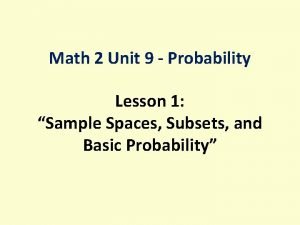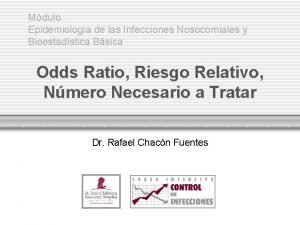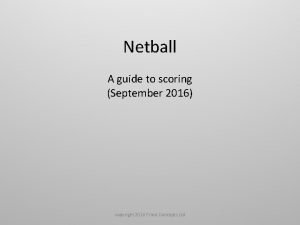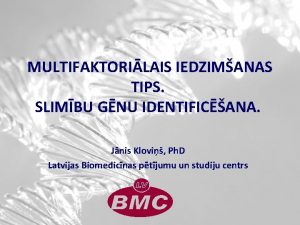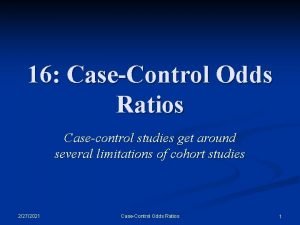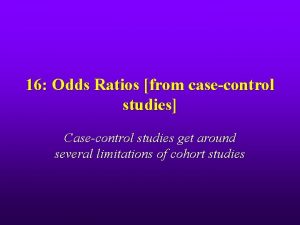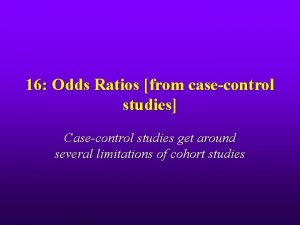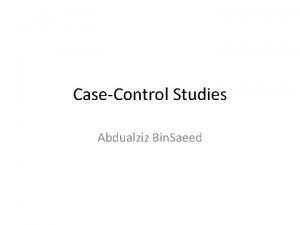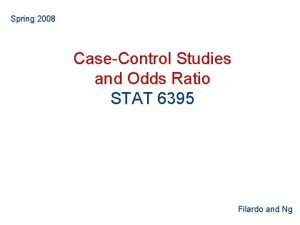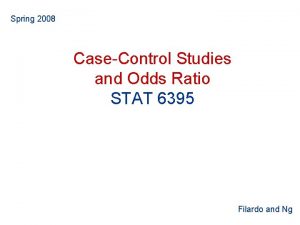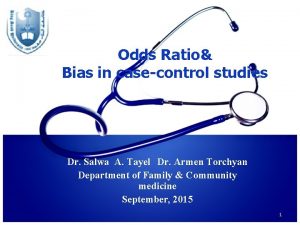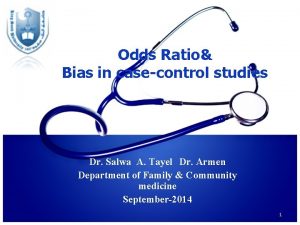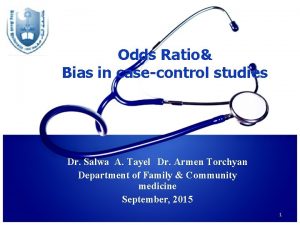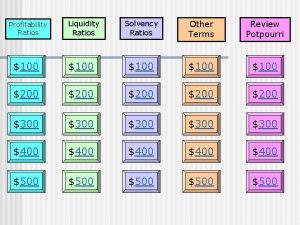16 CaseControl Odds Ratios Casecontrol studies get around















- Slides: 15

16: Case-Control Odds Ratios Case-control studies get around several limitations of cohort studies 2/25/2021 Case-Control Odds Ratios 1

Relative risks from cohort studies n Use incidences to assess risk n n Exposed group incidence 1 Non-exposed group incidence 2 RR = ratio of incidence relative measure of effect Hindrances in Cohort Studies n n n 2/25/2021 Long induction period between exposure & disease Study of rare diseases require large sample sizes When studying many people information is limited in scope & accuracy Case-Control Odds Ratios 2

n Case-control sample Study all cases (Proportion exposed reflects exposure proportion of cases in the population) n Select random sample of non-cases (Proportion exposed reflects exposure proportion of noncases in the population) n This design forfeits the ability to estimate incidence, but maintains ability to estimate relative risk via the odds ratio (Cornfield, 1951; Disease + - Total Exposed + a b n 1 Exposed - c d n 2 Total m 1 m 2 N Miettinen 1976) 2/25/2021 Case-Control Odds Ratios 3

Illustrative Example (Breslow & Day, 1980) n Dataset = bd 1. sav n n Exposure variable (alc 2) = Alcohol use dichotomized Disease variable (case) = Esophageal cancer Alcohol 80 g/day < 80 g/day Total 2/25/2021 Case 96 104 200 Control 109 666 775 Case-Control Odds Ratios Total 205 770 975 4

Interpretation of Odds Ratio n Odds ratios are relative risk estimates n Risk multiplier n n e. g. , odds ratio of 5. 64 suggests 5. 64× risk with exposure Percent increase or decrease in risk (in relative terms) = (odds ratio – 1) × 100% n n 2/25/2021 e. g. , odds ratio of 5. 64 Percent relative risk difference = (5. 64 – 1) × 100% = 464% Case-Control Odds Ratios 5

95% Confidence Interval n Calculation n n Illustrative example n n n Convert OR estimate to ln scale SEln. OR = sqrt(a-1 + b-1 + c-1 + d-1) 95% CI for ln. OR = (ln OR^) ± (1. 96)(SE) Take anti-logs of limits ln(OR^) = ln(5. 640) = 1. 730 SEln. OR = sqrt(96 -1 + 104 -1 + 109 -1 + 666 -1) = 0. 1752 95% CI for ln. OR= 1. 730 ± (1. 96)(0. 1752) = (1. 387, 2. 073) 95% CI for OR = e(1. 387, 2. 073) = (4. 00, 7. 95) Interpretation of confidence interval (discuss) 2/25/2021 Case-Control Odds Ratios 6

SPSS Output Odds ratio point estimate and confidence limits Ignore “For cohort” information when data derived by case-control sample 2/25/2021 Case-Control Odds Ratios 7

Testing H 0: OR = 1 with the CI n n 95% CI corresponds to a = 0. 05 If 95% CI for odds ratio excludes 1 odds ratio is significant n n n e. g. , (95% CI: 4. 00, 7. 95) is a significant positive association e. g. , (95% CI: 0. 25, 0. 65) is a significant negative association If 95% CI includes 1 odds ratio NOT significant e. g. , (95% CI: 0. 80, 1. 15) is not significant (i. e. , cannot rule out odds ratio parameter of 1 with 95% confidence Also use a chi-square test or Fisher’s test as needed n 2/25/2021 Case-Control Odds Ratios 8

Chi-Square, Pearson (Do not review) OBSER VED D+ D- Total EXPEC TED D+ D- Total E+ 96 109 205 E+ 42. 051 162. 949 205 E- 104 666 770 E- 157. 949 612. 051 770 Total 200 775 975 c 2 Pearson's = (96 - 42. 051)2 / 42. 051 + (109 – 162. 949)2 / 162. 949 + (104 - 157. 949)2 / 157. 949 + (666 – 612. 051)2 / 612. 051 = 69. 213 + 17. 861 + 18. 427 + 4. 755 = 110. 256 c = sqrt(110. 256) = 10. 50 off chart (way into tail) P <. 0001 2/25/2021 Case-Control Odds Ratios 9

Chi-Square, Yates (Do not review) OBSER VED D+ D- Total EXPEC TED D+ D- Total E+ 96 109 205 E+ 42. 051 162. 949 205 E- 104 666 770 E- 157. 949 612. 051 770 Total 200 775 975 c 2 Pearson's = (|96 - 42. 051| - ½)2 / 42. 051 + (|109 – 162. 949| - ½)2 / 162. 949 + (|104 - 157. 949| - ½)2 / 157. 949 + (|666 – 612. 051| - ½)2 / 612. 051 = 67. 935 + 17. 532 + 18. 087 + 4. 668 = 108. 221 c = sqrt(108. 22) = 10. 40 P <. 0001 2/25/2021 Case-Control Odds Ratios 10

SPSS Output Pearson = uncorrected Yates = continuity corrected Fisher’s unnecessary here Linear-by-linear not covered 2/25/2021 Case-Control Odds Ratios 11

Matched-Pairs Matching can be employed to help control for confounding (e. g. , matching on age and sex), with each pair representing an observation. Case E+ Case E− 2/25/2021 Control E+ Control E− Doesn’t matter n. A n. B Doesn’t matter Calculate 95% CI for ln OR with (ln estimate) ± (1. 96)(SE) and then take anti-logs of limits Case-Control Odds Ratios 12

Example (Matched Pairs) 2/25/2021 Control E+ Control E− Case E+ 5 30 Case E− 10 5 Case-Control Odds Ratios 13

Validity Conditions! No info bias (data accurate) n No selection bias (cases and controls random reflection of population analogues) n No confounding (association not explained by lurking factors!) n Validity conditions are nearly always the limiting factor in practice. 2/25/2021 Case-Control Odds Ratios 14

Mc. Nemar’s Test for Matched Pairs (not covered, use CI instead) Use Mc. Nemar’s chi-square to test H 0: OR = 1 (“no association”) for binary matched paired P for current example = 0. 0016 2/25/2021 Case-Control Odds Ratios 15
 Get on get off
Get on get off Refrain poetic device
Refrain poetic device Martin luther king of hinduism
Martin luther king of hinduism Examples of what goes around comes around
Examples of what goes around comes around Paradigm shift from women studies to gender studies
Paradigm shift from women studies to gender studies Get up get moving quiz
Get up get moving quiz Get up get moving quiz
Get up get moving quiz Get up get moving
Get up get moving Selection in pseudocode
Selection in pseudocode Get up get moving quiz
Get up get moving quiz Get focused get results
Get focused get results Perbedaan relative risk dan odds ratio
Perbedaan relative risk dan odds ratio Sample space probability worksheet
Sample space probability worksheet Odds ratio epidemiologia
Odds ratio epidemiologia How to score netball odds and even
How to score netball odds and even Odds ratio
Odds ratio












